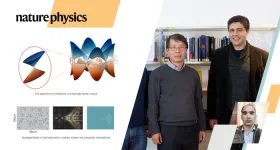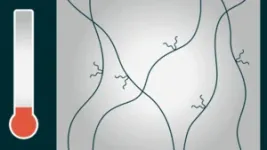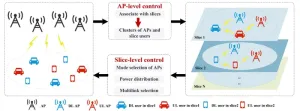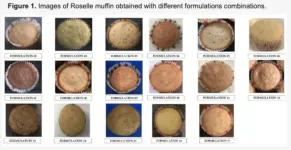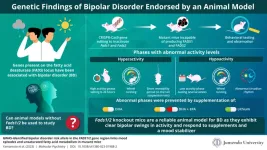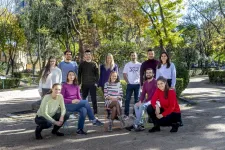(Press-News.org) Starting with the emergence of quantum mechanics, the world of physics has been divided between classical and quantum physics. Classical physics deals with the motions of objects we typically see every day in the macroscopic world, while quantum physics explains the exotic behaviors of elementary particles in the microscopic world.
Many solids or liquids are composed of particles interacting with one another at close distances, which sometimes results in the rise of “quasiparticles.” Quasiparticles are long-lived excitations that behave effectively as weakly interacting particles. The idea of quasiparticles was introduced by the Soviet physicist Lev Landau in 1941, and ever since has been highly fruitful in quantum matter research. Some examples of quasiparticles include Bogoliubov quasiparticles (i.e. “broken Cooper pairs”) in superconductivity, excitons in semiconductors, and phonons.
Examining emergent collective phenomena in terms of quasiparticles provided insight into a wide variety of physical settings, most notably in superconductivity and superfluidity, and recently in the famous example of Dirac quasiparticles in graphene. But so far, the observation and use of quasiparticles have been limited to quantum physics: in classical condensed matter, the collision rate is typically much too high to allow long-lived particle-like excitations.
However, the standard view that quasiparticles are exclusive to quantum matter has been recently challenged by a group of researchers at the Center for Soft and Living Matter (CSLM) within the Institute for Basic Science (IBS), South Korea. They examined a classical system made of microparticles driven by viscous flow in a thin microfluidic channel. As the particles are dragged by the flow, they perturb the streamlines around them, thereby exerting hydrodynamic forces on each other. This breakthrough has been jointly led by Group Leader Tsvi Tlusty (Department of Physics, UNIST) and Professor Professor Hyuk Kyu Pak (Department of Physics, UNIST) from CSLM.
Remarkably, the researchers found that these long-range forces make the particles organize in pairs (Figure 1 Left). This is because the hydrodynamic interaction breaks Newton’s third law, which states that the forces between two particles must be equal in magnitude and opposite in direction. Instead, the forces are ‘anti-Newtonian’ because they are equal and in the same direction, thus stabilizing the pair.
The large population of particles coupled in pairs hinted that these are the long-lived elementary excitations in the system — its quasiparticles. This hypothesis was proven right when the researchers simulated a large two-dimensional crystal made of thousands of particles and examined its motion (Figure 1 Right). The hydrodynamic forces among the particles make the crystal vibrate, much like the thermal phonons in a vibrating solid body.
These pair quasiparticles propagate through the crystal, stimulating the creation of other pairs through a chain reaction. The quasiparticles travel faster than the speed of phonons, and thus every pair leaves behind an avalanche of newly-formed pairs, just like the Mach cone generated behind a supersonic jet plane (Figure 1 Right). Finally, all those pairs collide with each other, eventually leading to the melting of the crystal (See Movie).
The melting induced by pairs is observed in all crystal symmetries except for one particular case: the hexagonal crystal. Here, the three-fold symmetry of hydrodynamic interaction matches the crystalline symmetry and, as a result, the elementary excitations are extremely slow low-frequency phonons (and not pairs as usual). In the spectrum, one sees a “flat band” where these ultra-slow phonons condense. The interaction among the flat-band phonons is highly collective and correlated, which shows in the much sharper, different class of melting transition.
Notably, when analyzing the spectrum of the phonons, the researchers identified conical structures typical of Dirac quasiparticles, just like the structure found in the electronic spectrum of graphene (Figure 2). In the case of the hydrodynamic crystal, the Dirac quasiparticles are simply particle pairs, which form thanks to the ‘anti-Newtonian’ interaction mediated by the flow. This demonstrates that the system can serve as a classical analog of the particles discovered in graphene.
“The work is a first-of-its-kind demonstration that fundamental quantum matter concepts – particularly quasiparticles and flat bands – can help us understand the many-body physics of classical dissipative systems,” explains Distinguished Professor Tsvi Tlusty, one of the corresponding authors of the paper.
Moreover, quasiparticles and flat bands are of special interest in condensed matter physics. For example, flat bands were recently observed in double layers of graphene twisted by a specific “magic angle”, and the hydrodynamic system studied at the IBS CSLM happens to exhibit an analogous flat band in a much simpler 2D crystal.
“Altogether, these findings suggest that other emergent collective phenomena that have been so far measured only in quantum systems may be revealed in a variety of classical dissipative settings, such as active and living matter,” says Hyuk Kyu Pak, one of the corresponding authors of the paper.
Their findings have been published in the January 2023 issue of Nature Physics.
Tsvi Tlusty
Distinguished Professor, Department of Physics, UNIST
Group Leader, IBS Center for Soft and Living Matter (CSLM)
E: tsvitlusty@gmail.com
William I. Suh
Public Information Officer
T: +82-42-878-8137
E:willisuh@ibs.re.kr
Story Source
Materials provided by Institute of Basic Science.
Notes for Editors
The online version of the original article can be found HERE.
Journal Reference
Imran Saeed, Hyuk Kyu Pak, and Tsvi Tlusty, “Quasiparticles, Flat Bands, and the Melting of Hydrodynamic Matter,” Nature Physics, (2023).
END
Network-assisted full-duplex (NAFD) systems enable uplink and downlink communications within the same time-frequency resources, so as to avoid the overhead of switching uplink/downlink modes. However, as the number of users and access points (APs) proliferated, mass access brings significant overhead in mode selection. In addition, the differentiated service demands among users also makes the effective utilization of resources difficult. Combined with network slicing technology, a slicing capacity-centered mode selection and resource optimization scheme is proposed. This scheme adopts a double-layer deep reinforcement ...
“As a Black woman, I’m invisible. They just erase your humanity. You don’t exist in front of them.” (Tessa, 33-year-old Black research assistant)
“It wasn’t about disliking what I did or being judgmental of what I did. It was a different kind of problem, to not be acknowledged. They didn’t care. There was no curiosity. They didn’t give a f***. We were invisible.” (Brinda, 30-year-old South Asian consultant)
Invisibility is a salient and recurring experience of mistreatment for women of colour working in traditionally white and male professions, two ...
Love muffins? We’re talking about a tasty, fluffy muffin that has no artificial additives and that simultaneously contains lots of beneficial nutrients. As remarkable as it might sound, a recently published study led describes the development of just such a new muffin in the journal Foods.
From muffins to functional food
The new super muffin has been named Roselle, because it contains calyx extract from the tropical plant Hibiscus sabdariffa, which is often referred to by the same name.
[caption id="attachment_79738" align="aligncenter" width="559"] Here's a look at the different formulations that researchers tested. Photo: Screenshot from Food ...
Will AI drive the next biomedical revolution? Why is RNA so powerful? What can we learn from studying bias? You’ll get the answers to these questions and more at Discover BMB, the annual meeting of the American Society for Biochemistry and Molecular Biology, to be held March 25–28 in Seattle.
Reporters are invited to register for a complimentary press pass to attend #DiscoverBMB in Seattle or to access press materials electronically.
This year’s #DiscoverBMB program features leading ...
Color plays a huge role in our lives — the hues we wear and decorate with are a way for us to signal who we are, where we’re from, and what we care about. And it’s been that way for a long time. In a new study in the Journal of Archaeological Science: Reports, archaeologists compared the colors on pieces of ancient Peruvian pottery. They found that potters across the Wari empire all used the same rich black pigment to make ceramics used in rituals: a sign of the empire’s influence.
The Wari empire spread over Peru’s highlands and coastal areas from 600-1050 ...
According to NOAA Fisheries, more than 80 percent of marine aquaculture production in the United States consists of bivalve mollusks such as oysters, clams and mussels. However, it’s not just humans who enjoy eating these shellfish, so do marine rays. They like to “crunch” on clams, which can sometimes take a big bite out of clammers’ profits.
Part of the process of culturing hard clams (Mercenaria mercenaria) involves deploying them in submerged bottom leases in the marine environment where clams can grow to market size. When deployed onto the clam lease, clammers incorporate a variety of anti-predator ...
AMES, IA — With the youngest baby boomers sliding into retirement, adults aged 65 and older are expected to outnumber children by 2030. The demographic shift will be a first in U.S. history. But many rural areas, especially in the Midwest and Great Plains, are already experiencing this.
Researchers are looking to small towns in Iowa to understand how some support aging in place better than others. Their findings, published in Journal of Rural Studies, could help communities plan for the ...
Bipolar disorder (BD) is a debilitating condition characterized by alternating states of depression (known as depressive episodes) and abnormal excitement or irritability (known as manic episodes). Large-scale genome-wide association studies (GWASs) have revealed that variations in the genes present on the fatty acid desaturase (FADS) locus are linked to an increased risk of BD. Enzymes coded by FADS genes—FADS1 and FADS2—convert or "biosynthesize" omega-3 fatty acids into the different forms required by the human body. Omega-3 fatty acids like ...
Researchers have achieved a breakthrough to enable ‘perfectly secure’ hidden communications for the first time.
The method uses new advances in information theory methods to conceal one piece of content inside another in a way that cannot be detected.
This may have strong implications for information security, besides further applications in data compression and storage.
A group of researchers has achieved a breakthrough in secure communications by developing an algorithm that conceals sensitive information so effectively that it is impossible to detect that anything has been hidden.
The team, led by ...
The study supports the therapeutic benefit of this drug in postmenopausal patients with hormone-receptor negative breast tumours and RANK protein expression.
"These results revive the option of starting clinical trials of denosumab in breast cancer by selecting patients," says Eva González-Suarez, CNIO researcher and lead author.
The results are published today in the scientific journal EMBO Molecular Medicine.
The drug denosumab is currently used to treat osteoporosis and bone metastases. For more than a decade, its potential therapeutic benefit in the treatment of breast cancer has also been studied. However, due to conflicting clinical ...
